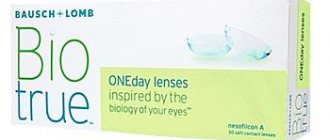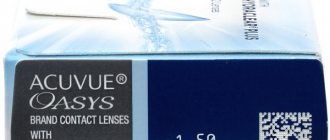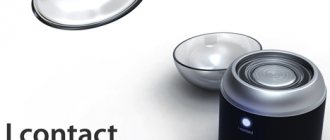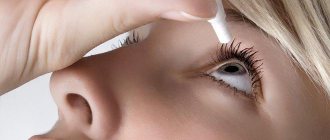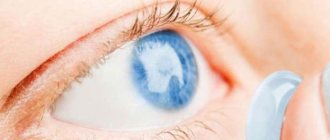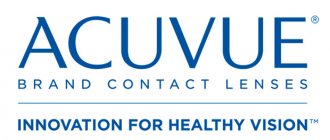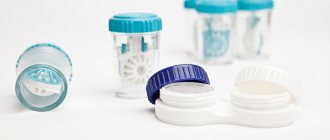Many people suffer from vision problems - some prefer to wear glasses the old-fashioned way, others risk losing their vision altogether due to laser correction surgery. However, more and more people are purchasing contact lenses. They cause virtually no discomfort; they are comfortable to work on a computer, play any sports and lead a fairly active lifestyle.
There are quite a few varieties of such products on the Russian market: most consumers prefer disposable or one-day products. Lenses are worn only once and thrown away after use. This is relatively convenient - there is no need to use a special storage solution or containers. If dust gets on the surface of the lenses, there is no need to clean them. Unfortunately, not all people are aware of the positive and negative aspects of this product. We decided to fill this gap and compiled a rating of the best daily lenses of the year. In it, we tried to tell you in as much detail as possible about the most popular products, and also provided some useful tips on choosing products.
General information about daily disposable contact lenses for eyes
This type of lens has a number of advantages that are difficult to keep silent about and which stand out against the background of other advantages of other optical products. Firstly, they allow you to minimize the time of getting used to a foreign object in the eye, since, most often, they are developed from extremely thin material. Plus, they perfectly allow air and oxygen to pass through, which, in turn, negates the occurrence of such an unpleasant phenomenon as hypoxia. Since replacement should be done every day, disposing of old lenses in the evening and putting on a new pair in the morning, the products do not require maintenance. On the one hand, this saves time that you could spend on cleansing, and on the other hand, it guarantees safety and sterility. There are no protein or lipid deposits on daily lenses, and bacteria do not multiply. These lenses are especially good for sensitive eyes, as well as for people prone to allergic reactions. Of course, these lenses cost a little more than bi-weekly or monthly optical products, but if you look differently, there is a chance to save on cleaning products and accessories. Below we will talk in more detail about the characteristics of such lenses and what parameters you should pay attention to when you select them.
For constant wear
They are characterized by low cost, since they consist of almost 50% water. Can be used for 3 months. It must be removed at night. The advantage is the ability to supply oxygen to the tissues of the eye.
One of the popular models is OK VISION Season - ultra-thin optics for quarterly wear. GELFLEX Sea Clear Vail is a popular company developing in the pharmaceutical market for the production of high-quality lenses.
Quarterly lenses are designed to last for three months. This option will save your budget, but there is a drawback - you need to buy a disinfectant designed for deep cleaning, since calcium salts and lipid particles will be deposited on the surface of the lens for a long time.
What are the characteristics of daily disposable lenses?
So, what should you pay attention to when choosing daily contact lenses? First, check with the manufacturer. Today, the ophthalmology market is extremely diverse, in this regard, you may give preference to a little-known brand that may not produce the highest quality or safest products. Accordingly, their price will be lower. There are a number of companies with an excellent reputation that have managed to establish themselves: they produce good products that are developed on innovative equipment using high-quality materials and advanced technologies. Below, in our article, we will give examples of the most popular brands and their best ephemera products.
The next point that is extremely important for any type of lens is oxygen permeability. Why is this characteristic so important? The thing is that the health of your eyes and the comfortable wearing of lenses will depend on this parameter. Another key point is moisture content. In terms of its significance, it is equal to the previous one. The higher the level of hydration in the contact lens, the more convenient it will be to use, and the eyes will not experience a burning sensation and a feeling of dryness. In order to produce such daily contact lenses, the manufacturer uses special moisturizing components.
Material. What the lenses are made from is very important: it determines whether they will be hard or soft. Hard lenses were one of the first, and today leading manufacturers most often make only soft daily lenses. Traditionally, hydrogel or silicone hydrogel is used. The latter material is considered more popular.
Stiffness or elasticity. Another key parameter for contact products, which will determine how well the lens follows the shape of the surface of the eye.
Allergy. It is very important that the wearer does not have any allergic reactions to the material from which the contact lenses are made. This doesn’t happen often: manufacturers have learned to make products that are as hypoallergenic as possible. By the way, hydrogel daily lenses contain more water and are less allergenic.
Classification
- Spherical.
- Tonic.
- Tough.
- Soft.
The above lenses vary in optical power size and duration of use.
- Tonic elements are of internal and external types. Prescribed for patients with myopia and astigmatism.
- Hard ones are divided into gas-permeable and regular. The first option is intended for patients with astigmatism. The period of application is no more than 1 year.
- The soft structures are made of hydrogel. Can be worn for no more than 30 days. Today there are models that dissolve independently, releasing medicinal substances into the eyeball. Disposable items are very expensive.
The advantage of daily lenses is that they require no maintenance. Any set contains from 10 to 180 designs made of high-quality materials. You can buy it in retail stores and commercial optical structures. One pair is designed for 18 hours of wear, after which the element is disposed of in the trash. In the production of ephemera, modern materials are used that reduce the potential development of complications. One can only assume that long-term wearing of lenses will restore vision, but there are also congenital pathologies that, if treated, are only treated in infancy or childhood under 4 years of age. Genetic predisposition to eye diseases can be stopped in a timely manner through the use of properly selected lenses.
Breathable lenses help restore correction, are almost imperceptible while wearing, expand the viewing angle, allow you to adjust lateral vision and create a cosmetic effect. Experienced ophthalmologists claim that only with the help of modern equipment it is possible to produce lenses with a high oxygen permeability coefficient, which promotes oxygen circulation.
The cornea receives O2 from the air and tear fluid, since it does not have blood vessels in its structure. If you sharply limit the nutrition of the cornea and white matter, there will be an impetus for the development of the process of neovascularization and the formation of a vascular network in the white matter, which will further block access to vision.
Breathable lenses are made from a unique silicone hydrogel composition, which, even in a solid state, is capable of transmitting oxygen to the eye, thereby moisturizing the cornea. Modern models of contact lenses guarantee their owner, subject to prolonged use, not only a clear image, but also comfort. Some models are designed for single use. Among breathable products, the most popular are:
- Astigmatic.
- Positive.
- Negative.
Astigmatism, like other vision pathologies, can be corrected. Ophthalmologists recommend using glasses due to the presence of two factors - low price and effectiveness. There is also the opposite side of wearing glasses: vision is reduced, the size and shape are distorted, and severe dizziness and discomfort in the eyes may occur. At sub-zero temperatures, condensation occurs behind the glass, resulting in the need to periodically wipe the glass with a dry cloth.
What types of daily contact lenses are there?
Dividing daily contact lenses into subgroups, oculists distinguish: silicone hydrogel, hydrogel, toric and colored hydrogel and cylindrical. Let's talk about each type in more detail.
Silicone hydrogel daily lenses are preferred by most consumers. The rating of the most popular optical products of this type includes lenses 1-Day Acuvue TruEye, ClearLux OneDay Aspheric, Maxima 1-Day Premium. The best one-day lenses from the first company, since the totality of their characteristics allows them to stand out from the rest of the three. The average oxygen permeability of optical products of this brand is 33%, which is a high figure that allows you to even sleep in such contact lenses. But this is not recommended - there are special optical products for such purposes.
Which hydrogel lenses should you choose? Experts recommend paying attention to such products as Biotrue ONEday, 1-Day Acuvue Moist, SofLens daily disposable. Number one on this list will be Biotrue ONEday. These contact lenses are good and are more in demand, since their oxygen permeability is more than 50%.
Colored hydrogel contact lenses. Of course, initially this type of contact product was used exclusively for cosmetic purposes, but today many manufacturers are developing models that can not only change eye color, but also correct vision or hide any imperfections. By the way, such lenses may also be suitable for sensitive eyes.
Daily toric lenses, in turn, are distinguished by the fact that they do not cause side effects even for those who have just started wearing lenses without having any previous experience. They perfectly follow the shape of the eyeball, are almost not felt when worn throughout the day and maintain clarity of vision. This type of lens, such as cylindrical, is characterized by a long period of adaptation. They are prescribed for astigmatism, that is, for deformation of either the cornea or the lens.
The best one-day contact lenses among this type of model are the following: 1-Day Acuvue Moist, Clariti 1 day toric. Let's look at each one separately. The first are the most famous and, perhaps, the best contact lenses for sensitive eyes, the second are more advanced and are made of silicone hydrogel.
Frequent replacement lenses (up to a month)
Manufactured using innovative technology. A small amount of water is added to the composition. The structure is equipped with high oxygen permeability, which is indispensable for professions that involve prolonged eye strain. Some models have UV filters that can block UV radiation. There are several versions on the market: ACUVUE Oasys with Hydraclear Plus, ALCON Air Optix plus HydraGlyde. These models can be worn for no more than two weeks with the obligatory condition of taking them off at night.
Which daily contact lenses are best?
We will try to answer the following key questions - what are the best contact lenses and what daily contact lenses for sensitive eyes should you choose?
From all of the above, perhaps everyone will put Johnson&Johnson[/anchor] daily contact lenses in first place. 1-Day Acuvue Moist is formulated with a material called Etafilcon A. It is highly permeable and retains moisture. In addition, these products are very soft, so they do not injure the cornea if accidentally displaced and are best suited for people with increased sensitivity. Next on the list are the Dailies AquaComfort Plus daily contact lenses from Alcon. Among other characteristics, they are equipped with a good UV filter and boast an excellent aspherical shape, which allows you to see the picture as clearly as possible, without distorted color rendition.
Biotrue ONEday from Bausch + Lomb is another popular contact lens that is made from HyperGel. This material is notable for the fact that its moisture content is about 78%, so you will never remember dry eyes and other unpleasant sensations. Today they are the “most” daily lenses, simply put, the favorites of customers around the world.
In turn, Proclear 1 Day soft contact lenses from CooperVision are developed using PC technology, which, in turn, guarantees optimal hydration of the cornea throughout the entire period of use and maximum comfort while wearing. All of the above daily contact lenses are the most popular, as evidenced by positive reviews from regular customers of our site. Many specialists in the field of ophthalmology also come to similar conclusions.
Who needs one-day SCLs?
There are a huge number of patients who are recommended to use “one-day” medications. The main indications for such lenses may be:
- Production of large amounts of proteins and fats that will be deposited on the lens. It will be difficult to wash them off, even with the help of a special liquid.
- During prolonged stay in unfavorable conditions.
- With hypersensitivity to pollen of various plants.
- Diabetes.
Daily lenses are suitable for people with allergies
Which daily lenses are best for people with a specific lifestyle?
When you find yourself in an ophthalmologist's office, he is sure to be interested in your lifestyle and occupation in order to understand which contact lenses will suit you best. Many experts say that daily contact lenses are needed for people who:
- exercise regularly;
- often travel;
- they constantly go to the sea and love to be in the water;
- work in hazardous work;
- have had conjunctivitis or other diseases of the cornea.
Due to the short period of use, daily lenses do not accumulate bacteria that cause unpleasant consequences. They are convenient to take with you on the road, without worrying about having a special solution or storage container. These vision correction products are also suitable for those who are tired of uncomfortable glasses.
The importance of observing wearing times
It is a misconception when they say that you can wear daily lenses for several days. Once removed, the optics are thrown away.
If you neglect the period of use of the correction product, then there is a risk of the following problems:
- oxygen starvation, as a result of which the functioning of the optic nerve is disrupted;
- the risk of an inflammatory process (conjunctivitis, keratitis) increases due to the decline of protein deposits and dirt on the surface of the optics.
It is not recommended to sleep with daily lenses on your eyes. The procedure of removing and putting on is carried out with cleanly washed hands, as the lenses are taken with the pads of the fingers. If you take it with tweezers, the surface is damaged.
Properly selected vision correction products are comfortable and invisible to others. Unlike glasses, they do not narrow your horizons.
Author's rating
Author of the article
Alexandrova O.M.
Articles written
2029
about the author
Was the article helpful?
Rate the material on a five-point scale!
If you have any questions or want to share your opinion or experience, write a comment below.
If you experience discomfort when using contact lenses?
Even properly fitted daily lenses can be a noticeable cause of discomfort. Therefore, you do not need to endure, but should immediately contact a specialist if minimal discomfort occurs. You should not delay visiting an ophthalmologist if there is burning, itching or deterioration in image quality because this may lead to more serious problems.
Today, daily contact lenses are the safest optical products and a high-quality alternative to glasses. Some types, such as toric or night glasses, easily replace glasses, and some can even be worn at night. However, before purchasing, consult an ophthalmologist and undergo a full examination to identify the exact disease and the absence or presence of allergic reactions to a particular material. Strictly follow all the rules for wearing and using daily contact lenses and remember that your health is in your hands.
MagazinLinz.ru team
Contraindications for the use of lenses
There are a number of pathologies and diseases for which it is prohibited to wear medical contact lenses designed to improve visual acuity:
- Inflammatory diseases of the eyelid, white matter, mucous membrane.
- Presence of a foreign body.
- Dry eye syndrome.
- Blepharitis.
- Keratitis.
- Strabismus.
- Glaucoma.
- Lens luxation.
- Obstruction of the lacrimal ducts.
- Disruption of the lacrimal glands.
- Decreased immunity.
- Inflammation of the upper or lower respiratory tract, ENT organs.
- HIV, tuberculosis, AIDS.
- Any viral infection.
- Allergic reactions.
- If you have diabetes, you should not wear reusable items.
